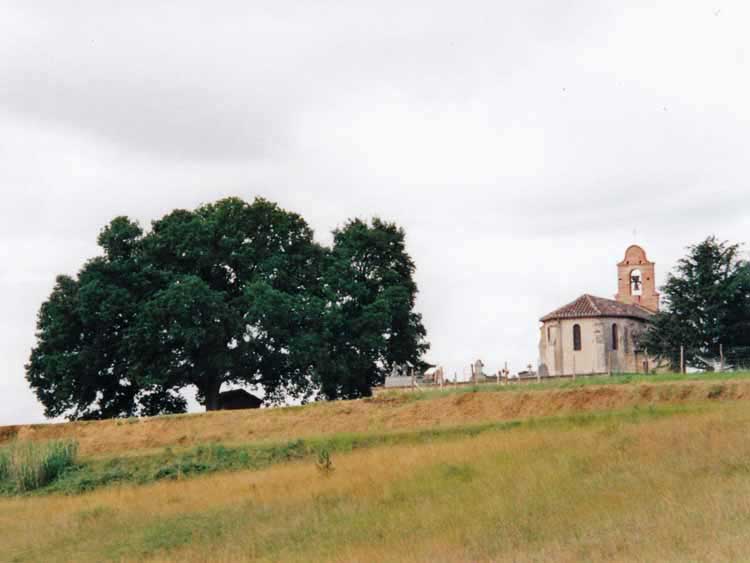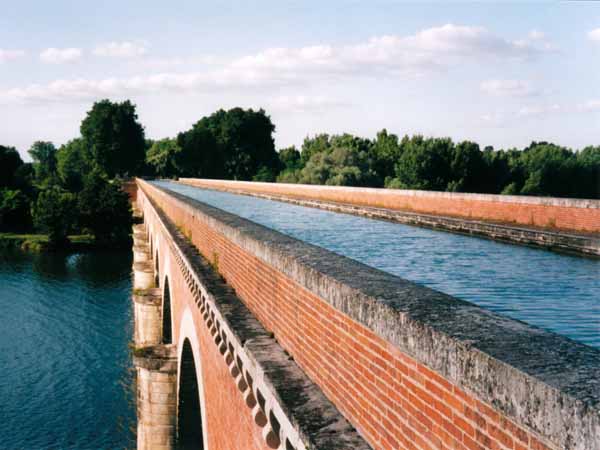Thursday, 4 July 2002
Distance 25 km
Map 57 of the TOP 100 blue series (now superseded)
Topoguide (Ref 652) Sentier de Saint-Jacques-de-Compostelle Figeac/Cahors/Agen/Moissac

For our last day on the track, we were packed and away by 7 o’clock.
Our aim was to cut around on the western side to avoid having to climb to the top, but something went wrong and we found ourselves rising much higher than we wanted to.
Eventually we got onto the GR65 as it descended and soon left the town behind.
A small road took us through smiling fields of wheat, garlic, vines and prune trees, so delightful to look at that we missed the GR turning sign and continued up the road to the ridge.
Fortunately it was easy to reconnect with the track by a side road, as it goes against the grain to retrace our steps.
A handsome pigeonnier on four legs recalled prerevolutionary days when only the nobility had the right to own such things.
At the foot of the slope was a chapel buried in the forest, damp and chilly, reminiscent of the chapel in the Auvergne where I tried to cure my blisters with holy water. By now the blisters were no more than patches of hard skin.

Having climbed up to a sunlit road, we came down through a cherry orchard, helping ourselves to a hatful of fruit from an overhanging tree.
A short road walk, then one more rise brought us to a beautiful expansive hillside of sunflowers, then a young walnut farm, a stream crossing and a last climb between vines, prunes and apricots to the isolated old inn called the Aube Nouvelle.
Here we stopped for morning coffee in the overgrown formal garden. The restorative power of this simple pleasure never fails to amaze us. It seemed a New Dawn as we strode off.

Soon we passed through godless Durfort, one of the few French villages with no church, but we found one on a rise not much further on. The oak tree beside it was centuries older than the church itself.
The track descended to a stream, where the road had been newly resurfaced and was blocked to cars, so we swung pleasantly along it instead of on the parallel GR.
Then, back on the track, there was an immense pull up to the ridge, which we just cruised up as though it were flat land, leaving the straggle of other pilgrims behind, never to be seen again. We have become very fit.
There were various tasty treats along the way – plums and huge apricots, as well as containers of cold water put out by the locals for passing pilgrims.
We had lunch in the shade of a hedge before the track dived into the streets of Moissac.

Our first impression was of a pinched and threadbare town, albeit quite large, sprawling along the river Tarn and the canal. It never recovered from the appalling floods of 1930, when many houses were swept away and 120 people killed.
The great glory of Moissac is the abbey church of Saint-Pierre with its awe-inspiring tympanum of Christ in Majesty and its cloisters.
The abbey was established in the seventh century, although the present buildings are from the golden age of pilgrimage in the twelfth century.
They went close to being flattened by the practical men who brought the railway through in the nineteenth century, but are now the backbone of the town’s economy.

We eventually found the camping ground on an island in the river, reached from the opposite bank via the Napoleon bridge. The reception building was an old water mill.
A little way upstream the Canal Lateral de la Garonne crosses the river on a handsome brick aqueduct.
This canal, together with the Canal du Midi, allows boats to go all the way from the Atlantic to the Mediterranean.
The sight of large boats sailing along far overhead took a bit of getting used to, but we strolled up to it and crossed the Tarn beside the canal.

For dinner we hunted about the shabby streets until we found the Place des Récollets, site of a former monastery of this order (French Franciscans), destroyed after the Revolution.
The open space now houses the covered market and is lined with cafes. Here we had a delightful outdoor meal of duck, steak, salad and icecream to finish.
That was the end of our walk in 2002, but we did return to France in 2003 and completed the French section of the Pilgrims’ Way to St-Jean-Pied-de-Port.
Previous day: Montcuq to Lauzerte